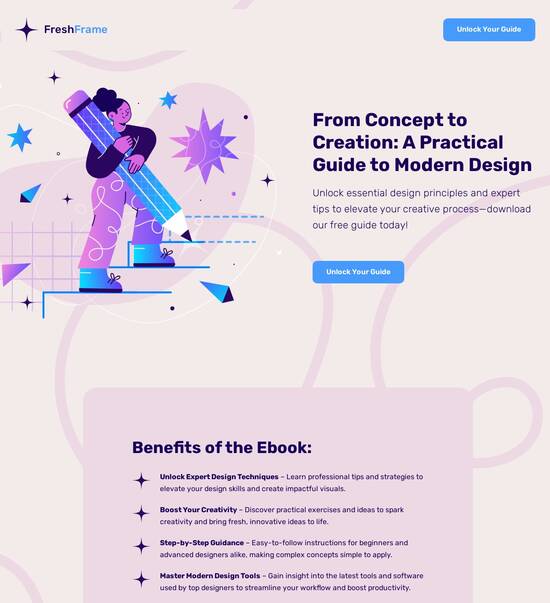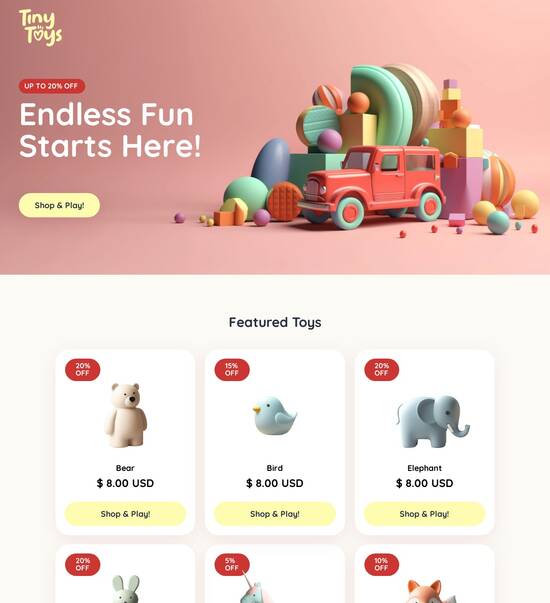
Knowledge base template compatible with Ghost
Explore Similar TemplatesAbout template
Streamline your content management with knowledge base templates designed for compatibility with Ghost.
Recommended templates

Easy to build without coding
With the intuitive drag-and-drop builder, anyone on your team can create high-converting pages without any knowledge of code or design. Make enhancements to your landing page with custom widgets using Javascript, HTML/CSS, or third-party scripts.

Multiple layouts for any industry and goal
Select from 500+ landing page layouts built to boost conversions across industry-specific scenarios. Customize them by adjusting fonts, adding images, and generating on-brand content with the AI assistant. Quickly scale with Instablocks® and Global Blocks that you can save, reuse, and update globally.

Loads fast and looks polished on any device
Every template is responsive, which means they present professionally on any device and load blazingly fast with our Thor Render Engine. You can also power them up with Google AMP technology to deliver an unparalleled mobile experience and drive higher conversions.

Robust analytics & experimentation
Get real-time updates and reporting across all your devices, showing the number of visitors, conversions, cost-per-visitor, and cost-per-lead. Launch AI-powered experiments, run A/B tests, and use heatmaps to analyze user behavior, then optimize your landing page to maximize conversions.







Easy to build without coding
With the intuitive drag-and-drop builder, anyone on your team can create high-converting pages without any knowledge of code or design. Make enhancements to your landing page with custom widgets using Javascript, HTML/CSS, or third-party scripts.
Multiple layouts for any industry and goal
Select from 500+ landing page layouts built to boost conversions across industry-specific scenarios. Customize them by adjusting fonts, adding images, and generating on-brand content with the AI assistant. Quickly scale with Instablocks® and Global Blocks that you can save, reuse, and update globally.
Loads fast and looks polished on any device
Every template is responsive, which means they present professionally on any device and load blazingly fast with our Thor Render Engine.
Robust analytics & experimentation
Get real-time updates and reporting across all your devices, showing the number of visitors, conversions, cost-per-visitor, and cost-per-lead. Launch AI-powered experiments, run A/B tests, and use heatmaps to analyze user behavior, then optimize your landing page to maximize conversions.
All the features you need to build lead-generating landing pages
Explore more featuresLearn how to build top-performing landing pages for any goal
FAQs
Leading the way in building high-performing landing pages





A step-by-step guide to utilizing Instapage for effective landing page optimization
Landing page optimization is crucial for maximizing conversion rates in your marketing campaigns. With Instapage, marketers in sectors like business services, tech, and financial services can leverage advanced tools and features designed to enhance their digital marketing strategy. This guide will walk you through the effective steps to create and optimize landing pages that will drive results.
Understanding the essentials of landing page creation
To create a high-converting landing page, start by understanding the core elements involved. Instapage offers over 100 high-converting templates that can cater to different industry needs. The intuitive drag-and-drop builder allows you to customize layouts easily. Key features include:
- Templates: Access a wide array of ready-to-use templates suited for various industries.
- Lead generation tools: Built-in forms and CTA elements streamline the process of capturing leads.
- Mobile optimization: Ensure your landing pages are responsive and optimized for mobile devices.
Step 1: Crafting a compelling landing page with Instapage
When you're ready to build your landing page, follow these steps to ensure maximum effectiveness:
- Select a template that aligns with your campaign goals, focusing on a design that clearly articulates your value proposition.
- Utilize Instablocks to save time by reusing sections from previous projects, keeping your branding consistent.
- Incorporate strong, actionable CTAs that compel visitors to convert immediately.
Step 2: Optimizing for conversions
Once your landing page is set up, it’s critical to optimize it for higher conversions. Consider these strategies:
- A/B testing: Use Instapage's built-in experimentation tools to test different variations of your landing page.
- Heatmaps: Analyze user behavior on your page to identify what draws attention and where visitors lose interest.
- Analytics dashboard: Review performance metrics to continuously refine your approach based on user data.
Step 3: Personalization to enhance user engagement
Personalizing your landing pages can significantly enhance user engagement and conversion rates. Implement these strategies:
- Dynamic text replacement: Tailor content to meet the specific needs and interests of individual audience segments.
- AdMaps: Align advertising campaigns directly to landing page content for a seamless user experience.
- Audience tracking: Use data tools to measure how different demographics engage with your page and adjust accordingly.
By following these structured steps, you can effectively harness the power of Instapage to create high-converting landing pages.
Ready to elevate your marketing campaigns? Start using Instapage today to build and optimize landing pages that not only attract but convert!
People also ask about Knowledge base template compatible with Ghost
Knowledge base template compatible with Ghost
Understanding the knowledge base template in Ghost
Ghost is a modern publishing platform designed to simplify the process of publishing online. Initially launched in 2013 as a focused blogging platform, Ghost has evolved into a powerful content management system (CMS) tailored for professional publishing. Today, it stands out due to its speed, simplicity, and built-in SEO capabilities, appealing to bloggers, publishers, and businesses alike. Its unique architecture, which relies on a minimalist design, ensures that users can create visually appealing pages without overwhelming features or complexities.
What sets Ghost apart from other platforms is its focus on speed and efficiency. Unlike other CMS options, Ghost utilizes a JavaScript framework that allows for quick loading times and a seamless user experience. Additionally, its content editor is markdown-enabled, enabling writers to format text effortlessly while maintaining a clean and engaging look for readers.
Purpose of a knowledge base template
A knowledge base is a centralized repository that provides users with information, FAQs, and tutorials related to a product or service. It serves a crucial role in enhancing user experience by empowering users to find answers to their questions proactively. By offering self-service options, a knowledge base reduces dependency on customer support, allowing teams to focus on more complex issues.
Moreover, having a well-structured knowledge base can significantly improve customer satisfaction. It provides immediate accessibility to information, which is particularly valuable when time-sensitive queries arise. By implementing a knowledge base template in Ghost, businesses can ensure that users find it easier to access essential information without navigating through complex menus.
Core features of knowledge base templates
Knowledge base templates built for Ghost come with a pre-configured structure designed to accommodate various types of content, such as FAQs, guides, and tutorials. This ready-made documentation layout allows for efficient categorization of information, making it easier for users to navigate and locate the content they need. The distinct sections can help clarify the information hierarchy, guiding users smoothly from general topics down to specific guides directed at their unique queries.
In addition to layout components, user-centric design principles are integral to the effectiveness of knowledge base templates. The design of a knowledge base impacts both concentration and performance, where clean layouts optimize user interactions. Techniques utilizing ample white space, readable typography, and relevant imagery throughout guides enhance reader engagement, helping users understand and retain information.
Further, integrating meta information and SEO optimization is vital for any knowledge base. Including pertinent meta tags, descriptions, and structured data enhances the visibility of documents in search engines, effectively driving more traffic to your knowledge base. Improved discoverability leads to a higher likelihood of users finding relevant answers, ultimately reducing support queries.
Benefits of using a knowledge base template with Ghost
Implementing a knowledge base template within the Ghost ecosystem serves multiple purposes, particularly streamlining user support. By enabling self-service options through an organized knowledge base, businesses can substantially decrease the volume of user inquiries received. Users will appreciate the ease of access to necessary information, which translates to quicker solutions without waiting for support responses. Ultimately, this saves time for both users and support teams.
Beyond streamlining support, knowledge bases also enhance the overall user experience. With intuitive navigation and easy access to commonly sought information, users are more likely to stay engaged with the content. Personalization features available on some templates allow organizations to showcase tailored solutions based on user behavior, enhancing relevance and connection.
Furthermore, a well-optimized knowledge base template contributes to boosting site performance. Templates designed for higher loading speeds ensure users have quick access to the resources they need, preventing drop-off due to long wait times. Maintaining knowledge bases through performance analytics permits teams to identify bottlenecks and optimize the content delivery further, aligning with user expectations.
Customization opportunities within Ghost knowledge base templates
One of the standout features of Ghost knowledge base templates is the flexibility in customization options. Tailoring themes allows businesses to reflect their brand identity accurately. Adjusting colors, fonts, and layouts can increase brand trust and engagement, providing a professional and cohesive experience to users while navigating the knowledge base.
Moreover, integrating multimedia elements enhances user engagement. Incorporating videos, audio, and interactive content captures user interest and caters to diverse learning preferences, effectively making the knowledge base more comprehensive. This not only adds depth to traditional text-based documentation but also enriches the user experience significantly.
Additionally, the support for plugins and integrations within Ghost facilitates a more robust knowledge base setup. Various plugins can enhance the functionality of a knowledge base, from chat support systems to analytics tools. By integrating third-party services, organizations can streamline processes, improve service efficiency, and further personalize the experience for users.
Real-world applications and case studies
Many industries have successfully implemented knowledge bases using Ghost. For instance, a leading software company has leveraged a Ghost-powered knowledge base to provide comprehensive documentation and user support. By structuring FAQs and guides effectively, they have significantly decreased their customer support load while attaining higher customer satisfaction scores. Not simply a tool for lowering inquiries, their knowledge base has become a go-to resource for users seeking information.
Similarly, an educational institution utilized a knowledge base to support students with online courses. The school created a series of tutorials and guides using Ghost, responding to frequent student queries. With the implementation of this knowledge base, they reported a notable drop in direct support requests, demonstrating that users prefer self-service solutions when designed correctly. The resulting positive feedback from students highlighted a marked improvement in their overall learning experience.
Both examples showcase the transformative power of a well-implemented knowledge base in enhancing user experience and addressing support needs effectively. Organizations can benefit tremendously from applying best practices in structure, content creation, and user engagement strategies.
Best practices for creating effective knowledge base content
Writing clear and concise documentation is crucial for an effective knowledge base. To achieve clarity, it's important to avoid jargon and focus on straightforward language. Techniques like bullet points, subheadings, and short paragraphs can help break down information, making it more digestible for users. Consistency in language and terminology is equally important to ensure users can easily follow along and understand the documentation.
Regular updates and maintenance are key to keeping knowledge base content current. Setting up a review schedule allows teams to ensure that their resources remain relevant and accurate. Such practices not only guarantee that old information does not mislead users but also reflect positively on the organization’s commitment to user support.
Moreover, gathering and utilizing user feedback is essential for continuous improvement. Engaging with users to collect insights on the knowledge base's effectiveness helps identify strengths and areas for enhancement. Iterating content based on real user interactions fosters a responsive and adaptable knowledge base, keeping it relevant as user needs evolve.
Future trends in knowledge base development
The future of knowledge bases is being shaped by advancements in technology, particularly AI and automation. Solutions incorporating machine learning can facilitate enhanced self-service capabilities, with chatbots providing instant responses based on knowledge base content. Integrating these technologies with Ghost has the potential to streamline user interactions and provide immediate, context-aware responses.
In addition to AI solutions, there is a notable shift towards interactive content within knowledge bases. Users now expect engaging materials, such as quizzes and interactive tutorials, which allow for a hands-on approach to learning. As this trend evolves, knowledge base platforms like Ghost will need to adapt their templates to support more dynamic forms of content.
There is also an increasing emphasis on data-driven decisions in knowledge base development. Collecting analytics on user behavior can inform future content strategies, highlighting which documents are most accessed and what topics may require further elaboration. This approach not only enhances the overall effectiveness of the knowledge base but aligns with user needs and expectations over time.
Conclusion: The transformative impact of knowledge base templates
In summary, knowledge base templates compatible with Ghost offer numerous advantages for both users and service providers. They streamline user support, enhance the user experience, and optimize site performance through well-structured content. By leveraging the features available in Ghost, organizations can create an efficient knowledge base that delivers relevant information directly to users, fostering greater trust and satisfaction.
As the role of knowledge bases evolves within our software and service ecosystems, organizations that prioritize user experience will establish a competitive edge. Embracing innovations and continually adapting documentation strategies will ensure that knowledge bases remain vital resources in meeting user demands and enhancing service delivery.
Ready to skyrocket conversions?
Supercharge your ad campaigns with high-performing landing pages
Get started














